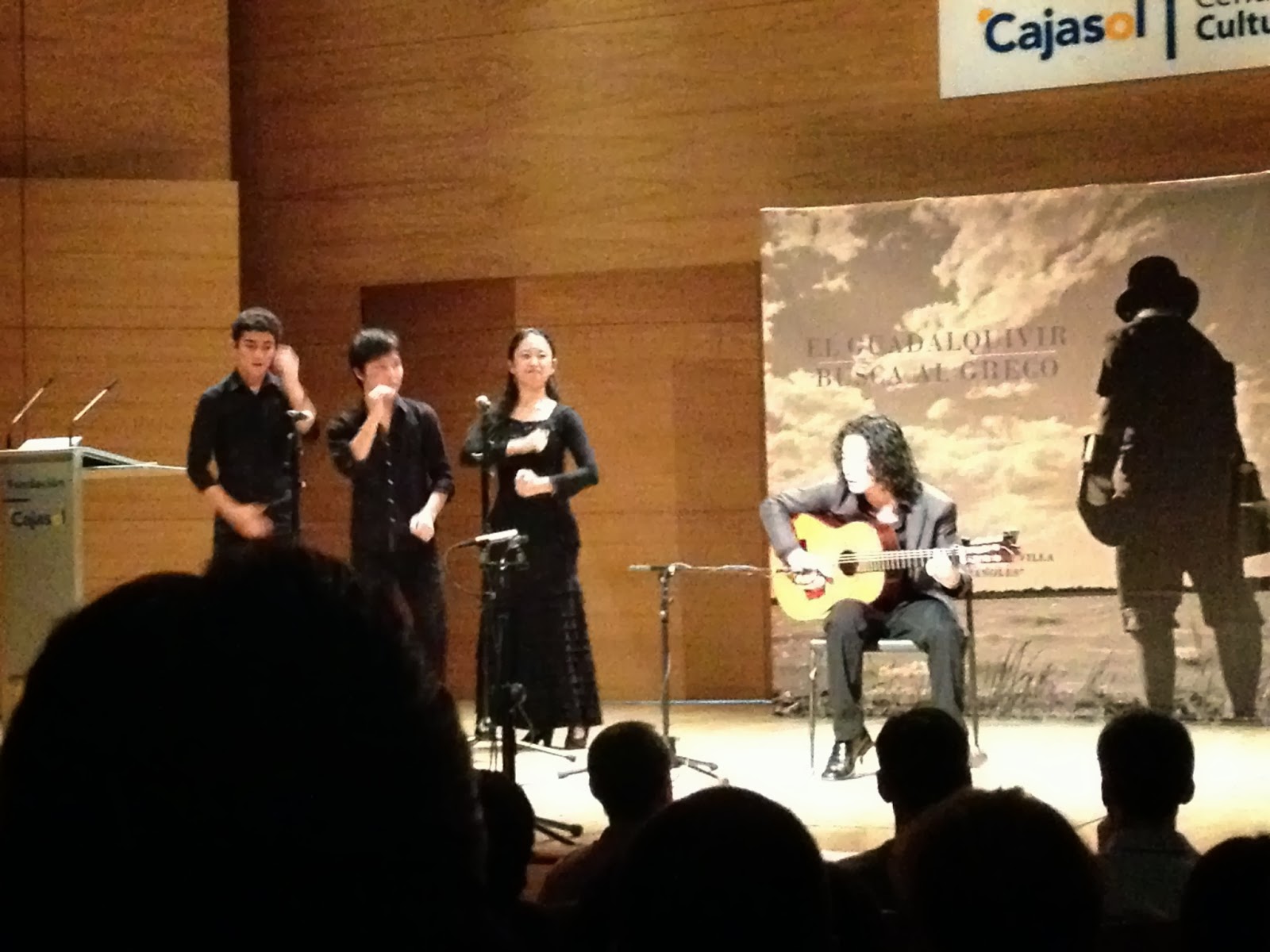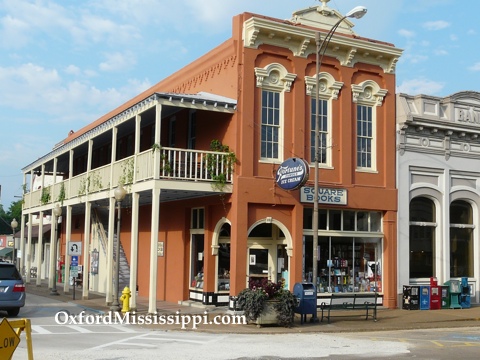On
a narrow cobbled street near the river, my friend and I followed the muffled
sound of socialization and at last found what we were looking for: La Casa de
Max. We pushed open a big black door and found ourselves in a dimly let space
that must have once been a garage or basement, and had been converted into a
venue. A skull on the wall made me feel vaguely like I was in Little Five
Points in Atlanta. Elongated wrought iron stick figures that seemed to dance
and stretch supported a rounded raised stage.
At
length from behind a gate that could have belonged in a haunted house came
three masked men. They called themselves Los Poetas Pluscuamperfectos (The
Pluperfect Poets). Two wore Mexican lucha libre masks, and one wore a black
sack cloth over his face. Already in character, they began their performance—a
mixture of theater and poetry reading that formed an extended and ironic ode to
“el odio” (hatred). Max, whose house it was, puffed calmly on a cigarette in
the shadowy background as he managed the remixed salon music from the twenties
that played softly throughout.
Here
I was, in el casco antiguo—the old part of town—enjoying a show that had
nothing to do with the flamenco shows put on for guiris (foreigners), the
baroque churches, the processions of virgins—in short, it had nothing to do
with what one might expect to find in the old part of a storied Andalusian city
like Sevilla. And yet, this experimental performance and funky venue, I have
learned, are examples of something that is far from simplyan “alternative” to
this other Sevilla that we think of. They are part of one of the many Sevillas
present in this city that continues to surprise me. These Sevillas are not
exclusive or independent of one another; they are different threads in the
larger fabric of the city. Some of these threads, like the warp on a loom, are somewhat
hidden away, while others, like the weft, are more obvious. But they nonetheless
work together (thought not always harmoniously) to sustain the city’s vibrancy.
I
recognized the poet with the Mexican accent behind his lucha libre mask. I
can’t tell you who it was because the Pluscuamperfectos are supposed to be
anonymous. But let’s just say that Iván Vergara, who had told me about this
event, only appeared after the performance was over and the poets had left the
stage. Iván, the energetic leader of the Plataforma Chilango Andaluz here in Sevilla,
had invited me to read that Thursday at his venue, Ultramarinos, for the eighth
annual installment of the Recital Chilango Andaluz, a dynamic poetry event that
takes place in Mexico City and Sevilla.* After experiencing the spectacle in La
Casa de Max, I wasn’t sure what to expect that Thursday, October 31st.
I
arrived at Ultramarinos on Halloween huffing and puffing, certain I was late. It
was fifteen minutes after the time I was supposed to be there to prepare for
the performance. But no—I was among the first ones there, including the other
poets who were supposed to read. Ultramarinos is accessed through a big black
door much like the entrance to La Casa de Max, except that the door opens to a
large corral, an old enclosure with a
complex of houses. Not many of these still exist in the city. Ultramarinos is
one of the houses in the corral—a venue with a cheap bar and books everywhere:
old copies of classics interspersed with beautiful handmade cardboard books
from Editorial Ultramarina. A few lucha libre masks hung from one wall.
All
the poems read were accompanied by video, sound, images, or some combination of
these. The poets ranged from nineteen or twenty to middle aged, and included
both women and men. I closed the show with a few pieces accompanied by Mexican
mariachi music and Spanish fandangos. Squinting in the darkness and addressing
this cozy place was a far different experience from performing poetry in Lowell
Lecture Hall at Harvard’s Presencia Latina. It was as if it was all a bit of a
secret.
 |
| My poetry reading at Ultramarinos |
At
a nearby bar called Un Perro Andaluz,** things were bigger and louder. A
reddish hue tinted everything, including the old books, the white piano, and
the writing on the walls. Two poets named Adriana read their poems to a crowd
that drank and clapped and listened and laughed in the light of a lamp that was
shaped like a woman but had a shade for a head. It was the first of a revival
of the series Las Noches del Cangrejo, a once-monthly event put together by
Cangrejo Pistolero Ediciones and spearheaded by the Cangrejo Pistolero himself,
the poet and editor Antonio García Villarán.
On
the second of the revived Noches del Cangrejo, the Perro welcomed a pair of
artists nicknamed Yellow and Vicio. They combined theater, music, and poetry in
a series of performances that had us all laughing. Perhaps the Sevilla of the
Noches del Cangrejo is not the Sevilla of the Poets of the Generation of 1927,
who sought to both revive the elusive poetry of the Baroque poet Luis de
Góngora and to break with modernismo. Or perhaps, in a way, it still is.
Perhaps this is the twenty-first century, crisis-driven response to more
traditional poetry readings. Perhaps Perfopoesía—performance poetry—is a
re-enactment the theatrics of the surrealist movement, but in a new, updated way
that serves the needs of Sevilla and the Sevillanos of 2013.
 |
| Antonio García Villarán and Nuria Mezquita present La Noche del Cangrejo in El Perro Andaluz |
I’ve
found other Sevillas, too. In Especie de Espacios, a bookstore right around the
corner from a dance school that serenades the street with flamenco stomps,
poets, novelists, and photographers comingle and peruse books by Sevilla
natives that share shelves with the Chilean Raúl Zurita’s Zurita and translations of Philip Roth novels. A section of the Mercado de Triana where I buy fresh groceries has
recently been converted into a theater. Money may be lacking for Sevillanos—but
not creativity, and an urge to re-invent and invigorate a city that is much
more than the Catholic, traditional Sevilla that the tourists see.
And
yet the traditional Sevillas do exist.
Just this past Sunday I hurried outside to watch the procession I knew must be
happening because of the loud, measured drumbeats I heard, as well as the
throngs of well-dressed people passing by my window—including small children in
their best camel, cherry red, and pastel blue outfits who chased each other and
laughed beneath my balcony before their parents hurried them on. A huge float
with a baby Jesus rising from an ornate complex of roses approached the
entrance of a church. A large crowd of young and old was gathered to
watch. A toddler kept repeating to his father who was about to duck back under
the float to help carry it, “Que te vaya bien, Papi! Que te vaya bien!” “I hope
it goes well for you, Daddy!”
 |
| A photo of a similar procession of a virgin in Triana. The virgins in Bar Garlochi resemble this. |
How
are we to make sense of this mixture of old and new, this perpetuation and
rupture of tradition all at once? One bar in the Alfalfa neighborhood in the
center of town offers a postmodern approach to addressing this question. A crying
virgin with a triangular golden robe that could easily be atop a traditional
processional float greets visitors at the entrance of Bar Garlochi. Enter and
the red and gold baroque niches and figures are too much to take in in one
night. In place of a virgin in one window-niche is the latest heiress of the
fortune of the Duchess of Alba. Here you can enjoy the house
cocktail Sangre de Cristo (Blood of Christ) and you might run into a novelist who
is drinking to help him decide what to tell his agent who wants to change the
title of his book. Behind the bar, the big-bellied owner serves drinks, keeps
tabs, and surveys his blasphemous church and its clientele contentedly.
The
city I am getting to know is a multifaceted mixture of the sacred and the
profane. In this post I have attempted to provide a few snapshots of the
Sevillas I have encountered. There are still many, many Sevillas of whose
existence I am not even aware—and a year here is not enough time to discover
them all.
*Chilango
is slang for someone from Mexico City, and Andaluz refers to being from the
Spanish region of Andalucía.
**A
reference to Salvador Dalí and Luis Buñuel’s film Un Chien Andalou











